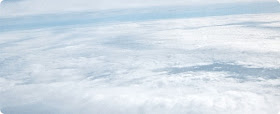SETS HIGH ALTITUDE RECORD!
 |
| Capsule atmospheric pressurization and heating is required at this altitude |
PRELIMINARY DATA
Temperatures were -46 degrees F. while accelerating at 600 miles per hour during re-entry. Data will undergo analysis over the next two weeks. Eighteen instruments carried aloft were the same as on the December Flight One lofted earlier.
THIS IS THE CONTINUING AND UNFOLDING SAGA OF THE BIG BRAIN'S MACHINE GROWTH WITH ITS REACH INTO OUTER SPACE.. Stay tuned as we continue to explore hobby space and pave the way towards more remarkable things...
IMAGES
The first digital image (above) was taken at ISO80 and f5.6 at 1/1000 second exposure, showing the Earth and a heavy cloud base. The second photo was taken at 3:02 pm, later in the flight, and shows the "eye" of a massive cloud weather front.
SPACE TECHNIQUES
Big Brain trips into space thus far are all relatively short suborbital flights. Human trips made into Near Space are more complicated, expensive and require more safety. One approach is to lease a launch vehicle. There are now many private companies (not run by the government) that can offer space time. Leasing can sublet safety and control, parts, design, and engage a ride aboard a system with many bugs worked out. This can save time, effort and money. Time and development revenue saved can go towards expanding the space program. As space programs evolve to explore deeper into space, cooperation can improve safety, cut time, and offer a path higher and deeper into the cosmos.
 |
| Looking up into the atmospheric launch hole |
Big Brain has at least five types of outer space exploration programs. The first program is in Micro Space and makes use of recruited insects known as insectronauts. The next level of space, known as Next Space, utilizes humans currently coined as astronauts. NS astronauts can hitch a ride aboard the worlds greatest Mega Project, for example, in China. The next level after Next Space is Near Space, also employs human astronauts. Going beyond farther and farther into space, we find Solar System Space, and Deep Space, explored by machines. For Big Brain Space studied, machines have explore 5 levels (Micro Space, Next Space, Near Space, Solar System Space, and Deep Space). Machines include Big Brain's telescopes, supercomputers and various machines (like the QuadLyzer), and use of NASA provided space junk, for reuse and recycle.
 |
| Button up. Would you jump out 7 miles high with -50 deg. (and -200 wind chill)? |
The third photo is processed. Clouds are part of a four month continual seasonal weather front. This flight confirms that -50 degrees F. and the chill factor of rushing wind require cold protection for both human and robotic space flights. It also shows that a powered and controlled "slower than NASA" re-entry is capable of eliminating the need for a heat shield. This flight also examined the water content and vapor above the record setting height of 7 miles.
The LU technique is used during every space launch. When peak altitude is reached, a look up approach can study the next mile or so of space. During this launch, LU discovers various strata conducive to specific space craft.
 |
| Three weather gradients become obvious at this altitude |
 |
| Large Earth span from the A2 vantage camera approaching 40,000 |
Speculation shows science stations and "Near Space satellites" could be placed within these stratas for protection. The strata itself may be conducive to flying special lofting craft. This opens up the possibility of light weight, ultra light "Lofted Science Packages," designed to stay aloft with longer time periods based on air pressure, wind forces and air directions. Also studied is the placement of tethers for space craft, space stations, harbors of scientific equipment and sub-orbital satellites, and great refueling stations and observatories. Exampling tethered BTs, or balloon telescopes can free drift image the solar system such as the Earth, Moon, or study the cosmos above most of the atmosphere. These flights pave the way for next science.
